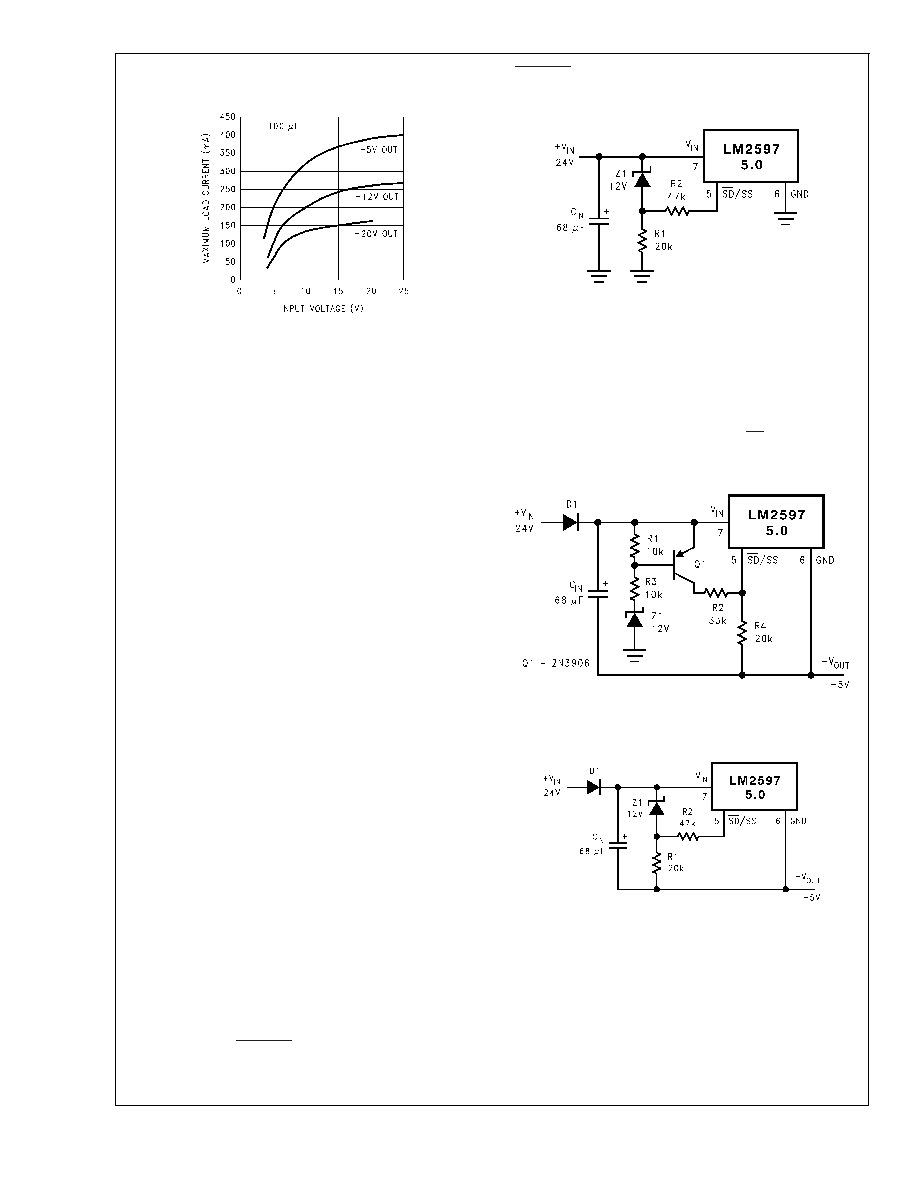- 您现在的位置:买卖IC网 > PDF目录30746 > LM2597-3.3MWA (NATIONAL SEMICONDUCTOR CORP) 1.4 A SWITCHING REGULATOR, 173 kHz SWITCHING FREQ-MAX, UUC PDF资料下载
参数资料
| 型号: | LM2597-3.3MWA |
| 厂商: | NATIONAL SEMICONDUCTOR CORP |
| 元件分类: | 稳压器 |
| 英文描述: | 1.4 A SWITCHING REGULATOR, 173 kHz SWITCHING FREQ-MAX, UUC |
| 封装: | WAFER |
| 文件页数: | 24/40页 |
| 文件大小: | 1019K |
| 代理商: | LM2597-3.3MWA |
第1页第2页第3页第4页第5页第6页第7页第8页第9页第10页第11页第12页第13页第14页第15页第16页第17页第18页第19页第20页第21页第22页第23页当前第24页第25页第26页第27页第28页第29页第30页第31页第32页第33页第34页第35页第36页第37页第38页第39页第40页

Application Information (Continued)
An additional diode is required in this regulator configuration.
Diode D1 is used to isolate input voltage ripple or noise from
coupling through the C
IN capacitor to the output, under light
or no load conditions. Also, this diode isolation changes the
topology to closely resemble a buck configuration thus pro-
viding good closed loop stability. A Schottky diode is recom-
mended for low input voltages, (because of its lower voltage
drop) but for higher input voltages, a 1N4001 diode could be
used.
Because of differences in the operation of the inverting
regulator, the standard design procedure is not used to
select the inductor value. In the majority of designs, a 100
H, 1 Amp inductor is the best choice. Capacitor selection
can also be narrowed down to just a few values. Using the
values shown in
Figure 29 will provide good results in the
majority of inverting designs.
This type of inverting regulator can require relatively large
amounts of input current when starting up, even with light
loads. Input currents as high as the LM2597 current limit
(approximately 0.8A) are needed for 1 ms or more, until the
output reaches its nominal output voltage. The actual time
depends on the output voltage and the size of the output
capacitor. Input power sources that are current limited or
sources that can not deliver these currents without getting
loaded down, may not work correctly. Because of the rela-
tively high startup currents required by the inverting topology,
the Soft-start feature shown in
Figure 29 is recommended.
Also shown in
Figure 29 are several shutdown methods for
the inverting configuration. With the inverting configuration,
some level shifting is required, because the ground pin of the
regulator is no longer at ground, but is now at the negative
output voltage. The shutdown methods shown accept
ground referenced shutdown signals.
UNDERVOLTAGE LOCKOUT
Some applications require the regulator to remain off until
the input voltage reaches a predetermined voltage.
Figure
31 contains a undervoltage lockout circuit for a buck configu-
ration, while
Figure 32 and Figure 33 are for the inverting
types (only the circuitry pertaining to the undervoltage lock-
out is shown).
Figure 31 uses a zener diode to establish the
threshold voltage when the switcher begins operating. When
the input voltage is less than the zener voltage, resistors R1
and R2 hold the Shutdown /Soft-start pin low, keeping the
regulator in the shutdown mode. As the input voltage ex-
ceeds the zener voltage, the zener conducts, pulling the
Shutdown /Soft-start pin high, allowing the regulator to begin
switching. The threshold voltage for the undervoltage lockout
feature is approximately 1.5V greater than the zener voltage.
Figure 32 and Figure 33 apply the same feature to an
inverting circuit.
Figure 32 features a constant threshold
voltage for turn on and turn off (zener voltage plus approxi-
mately one volt). If hysteresis is needed, the circuit in
Figure
33 has a turn ON voltage which is different than the turn OFF
voltage. The amount of hysteresis is approximately equal to
the value of the output voltage. Since the SD /SS pin has an
internal 7V zener clamp, R2 is needed to limit the current into
this pin to approximately 1 mA when Q1 is on.
NEGATIVE VOLTAGE CHARGE PUMP
Occasionally a low current negative voltage is needed for
biasing parts of a circuit. A simple method of generating a
negative voltage using a charge pump technique and the
switching waveform present at the OUT pin, is shown in
Figure 34. This unregulated negative voltage is approxi-
mately equal to the positive input voltage (minus a few volts),
and can supply up to a 100 mA of output current. There is a
requirement however, that there be a minimum load of sev-
DS012440-49
FIGURE 30. Maximum Load Current for Inverting
Regulator Circuit
DS012440-50
FIGURE 31. Undervoltage Lockout for a Buck
Regulator
DS012440-52
FIGURE 32. Undervoltage Lockout Without
Hysteresis for an Inverting Regulator
DS012440-53
FIGURE 33. Undervoltage Lockout With
Hysteresis for an Inverting Regulator
LM2597/LM2597HV
www.national.com
30
相关PDF资料 |
PDF描述 |
|---|---|
| LM2597HV-5MWC | 1.4 A SWITCHING REGULATOR, 173 kHz SWITCHING FREQ-MAX, UUC |
| LM2597-5.0MDA | 1.4 A SWITCHING REGULATOR, 173 kHz SWITCHING FREQ-MAX, UUC |
| LM2597-5.0MWA | 1.4 A SWITCHING REGULATOR, 173 kHz SWITCHING FREQ-MAX, UUC |
| LM2645MTDX/NOPB | SWITCHING CONTROLLER, 335 kHz SWITCHING FREQ-MAX, PDSO48 |
| LM2673LDX-12 | 5.4 A SWITCHING REGULATOR, 280 kHz SWITCHING FREQ-MAX, PDSO14 |
相关代理商/技术参数 |
参数描述 |
|---|---|
| LM2597HVM-12 | 功能描述:直流/直流开关转换器 RoHS:否 制造商:STMicroelectronics 最大输入电压:4.5 V 开关频率:1.5 MHz 输出电压:4.6 V 输出电流:250 mA 输出端数量:2 最大工作温度:+ 85 C 安装风格:SMD/SMT |
| LM2597HVM-12/NOPB | 功能描述:直流/直流开关转换器 RoHS:否 制造商:STMicroelectronics 最大输入电压:4.5 V 开关频率:1.5 MHz 输出电压:4.6 V 输出电流:250 mA 输出端数量:2 最大工作温度:+ 85 C 安装风格:SMD/SMT |
| LM2597HVM-12/NOPB | 制造商:Texas Instruments 功能描述:DC/DC Converter IC |
| LM2597HVM-3.3 | 功能描述:直流/直流开关转换器 RoHS:否 制造商:STMicroelectronics 最大输入电压:4.5 V 开关频率:1.5 MHz 输出电压:4.6 V 输出电流:250 mA 输出端数量:2 最大工作温度:+ 85 C 安装风格:SMD/SMT |
| LM2597HVM-3.3/NOPB | 功能描述:直流/直流开关转换器 RoHS:否 制造商:STMicroelectronics 最大输入电压:4.5 V 开关频率:1.5 MHz 输出电压:4.6 V 输出电流:250 mA 输出端数量:2 最大工作温度:+ 85 C 安装风格:SMD/SMT |
发布紧急采购,3分钟左右您将得到回复。